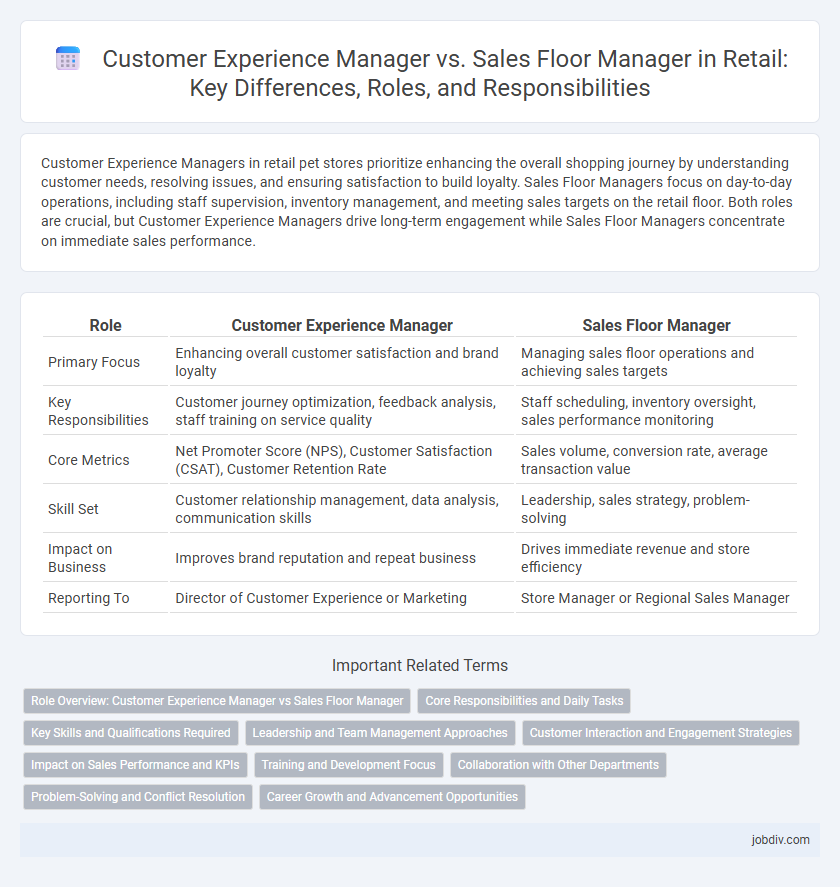Customer Experience Managers in retail pet stores prioritize enhancing the overall shopping journey by understanding customer needs, resolving issues, and ensuring satisfaction to build loyalty. Sales Floor Managers focus on day-to-day operations, including staff supervision, inventory management, and meeting sales targets on the retail floor. Both roles are crucial, but Customer Experience Managers drive long-term engagement while Sales Floor Managers concentrate on immediate sales performance.
Table of Comparison
| Role | Customer Experience Manager | Sales Floor Manager |
|---|---|---|
| Primary Focus | Enhancing overall customer satisfaction and brand loyalty | Managing sales floor operations and achieving sales targets |
| Key Responsibilities | Customer journey optimization, feedback analysis, staff training on service quality | Staff scheduling, inventory oversight, sales performance monitoring |
| Core Metrics | Net Promoter Score (NPS), Customer Satisfaction (CSAT), Customer Retention Rate | Sales volume, conversion rate, average transaction value |
| Skill Set | Customer relationship management, data analysis, communication skills | Leadership, sales strategy, problem-solving |
| Impact on Business | Improves brand reputation and repeat business | Drives immediate revenue and store efficiency |
| Reporting To | Director of Customer Experience or Marketing | Store Manager or Regional Sales Manager |
Role Overview: Customer Experience Manager vs Sales Floor Manager
Customer Experience Managers focus on enhancing overall shopper satisfaction by analyzing customer feedback, implementing engagement strategies, and ensuring seamless service across touchpoints to drive loyalty and repeat business. Sales Floor Managers prioritize in-store operations, overseeing sales staff, merchandising, and inventory management to maximize daily revenue and maintain an organized retail environment. Both roles are critical, with the Customer Experience Manager targeting long-term brand perception and the Sales Floor Manager optimizing immediate sales performance.
Core Responsibilities and Daily Tasks
A Customer Experience Manager prioritizes enhancing shopper satisfaction by analyzing feedback, developing service protocols, and training staff to ensure a seamless and personalized customer journey. In contrast, a Sales Floor Manager focuses on optimizing sales performance through inventory management, supervising sales associates, and executing merchandising strategies to meet daily revenue targets. Both roles collaborate closely but emphasize distinct aspects: customer engagement versus operational efficiency on the sales floor.
Key Skills and Qualifications Required
Customer Experience Managers require expertise in customer journey mapping, emotional intelligence, and data analytics to enhance satisfaction and loyalty, often holding degrees in marketing or business administration. Sales Floor Managers must possess strong leadership, inventory management, and sales forecasting skills, with experience in retail operations and team supervision. Both roles demand excellent communication and problem-solving abilities, but the Customer Experience Manager emphasizes strategic customer engagement while the Sales Floor Manager focuses on operational efficiency and achieving sales targets.
Leadership and Team Management Approaches
Customer Experience Managers prioritize empathetic leadership and foster a customer-centric team culture to enhance shopper satisfaction through personalized service strategies. Sales Floor Managers emphasize performance-driven leadership, focusing on real-time team coordination, sales targets, and inventory management to maximize revenue. Both roles require strong communication skills and conflict resolution abilities but diverge in their approach to motivating teams--customer loyalty versus immediate sales metrics.
Customer Interaction and Engagement Strategies
A Customer Experience Manager in retail prioritizes personalized customer interactions and implements engagement strategies that enhance overall satisfaction and loyalty through data-driven insights. In contrast, a Sales Floor Manager focuses on real-time customer service, managing staff to optimize sales opportunities and addressing immediate in-store customer needs. Both roles collaborate to balance strategic customer experience improvements with operational sales efficiency, driving increased revenue and brand loyalty.
Impact on Sales Performance and KPIs
A Customer Experience Manager drives sales performance by enhancing customer satisfaction metrics such as Net Promoter Score (NPS) and Customer Retention Rate, directly influencing repeat purchase behavior and average transaction value. In contrast, a Sales Floor Manager impacts key performance indicators (KPIs) like conversion rate, units per transaction, and daily sales volume by optimizing staff productivity and floor operations. Both roles are pivotal, yet the Customer Experience Manager emphasizes long-term revenue growth through customer loyalty, while the Sales Floor Manager focuses on immediate sales efficiency and operational execution.
Training and Development Focus
Customer Experience Managers concentrate on training staff in personalized service techniques and customer interaction skills to enhance overall shopper satisfaction. Sales Floor Managers prioritize operational training, emphasizing product knowledge, sales tactics, and inventory management to drive revenue and maintain efficient store performance. Both roles require ongoing development strategies but target different aspects of employee growth aligned with their core responsibilities.
Collaboration with Other Departments
Customer Experience Managers collaborate closely with marketing, product development, and customer service teams to design seamless shopping experiences and address customer feedback effectively. Sales Floor Managers work in tandem with inventory control, visual merchandising, and store operations departments to ensure optimal product placement and staff performance on the sales floor. Both roles rely on cross-departmental communication to enhance overall store performance and drive customer satisfaction.
Problem-Solving and Conflict Resolution
Customer Experience Managers excel in problem-solving by analyzing customer feedback and implementing strategies that enhance service quality, often addressing issues before they escalate. Sales Floor Managers focus on real-time conflict resolution by managing staff interactions and resolving customer disputes on the sales floor to maintain a positive shopping environment. Both roles require strong interpersonal skills, but Customer Experience Managers use data-driven insights, whereas Sales Floor Managers rely on immediate, hands-on decision-making.
Career Growth and Advancement Opportunities
Customer Experience Managers often have broader career growth opportunities due to their strategic role in enhancing customer satisfaction and loyalty, which directly impacts long-term business success. Sales Floor Managers typically focus on day-to-day retail operations and staff coordination, offering growth primarily in operational management or store leadership roles. Advancing as a Customer Experience Manager can lead to senior roles in customer strategy, marketing, or corporate leadership, while Sales Floor Managers may progress to district or regional management positions within retail operations.
Customer Experience Manager vs Sales Floor Manager Infographic

 jobdiv.com
jobdiv.com